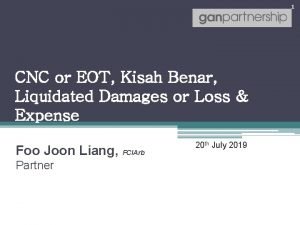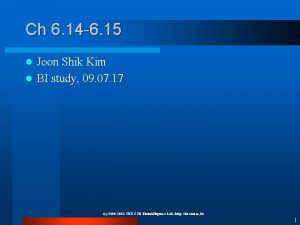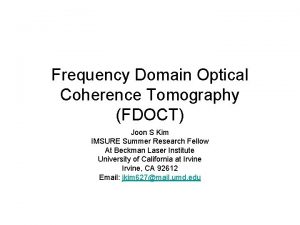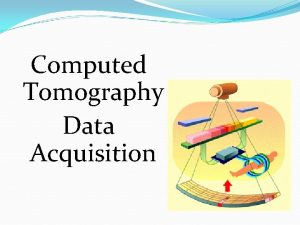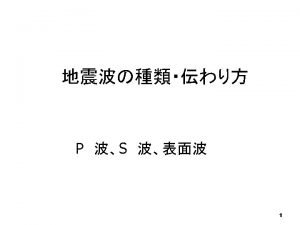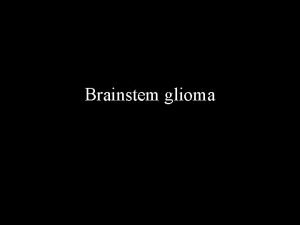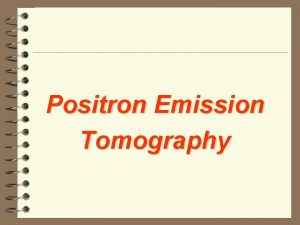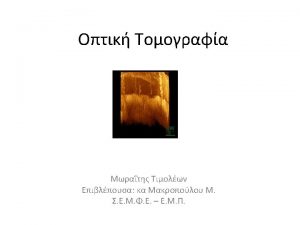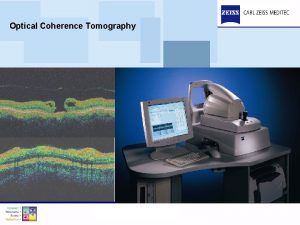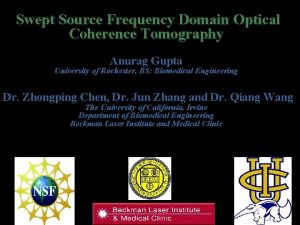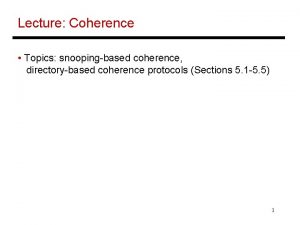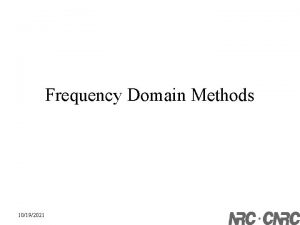Frequency Domain Optical Coherence Tomography FDOCT Joon S










- Slides: 10

Frequency Domain Optical Coherence Tomography (FDOCT) Joon S Kim IMSURE Summer Research Fellow At Beckman Laser Institute University of California at Irvine, CA 92612 Email: jkim 627@mail. umd. edu

OCT • Optical Coherence Tomography – New field of imaging technology that can complement conventional imaging techniques – Based on interference of EM wave – Provide high spatial resolution cross-sectional view of tissues without excision – Endless potential biomedical applications • Non-invasive Diagnostics

OCT vs. Conventional Imag. Tech Resolution (log) Standard clinical 1 mm Ultrasound 100 mm 10 mm High frequency Confocal microscopy OCT 1 mm Penetration depth (log) 1 mm 1 cm 10 cm

Two kinds of OCT • TDOCT – Time Domain OCT – Use of Scanning Mirror • FDOCT – Fourier (Frequency) Domain OCT – Use of laser source over band of optical frequency – Advantages over TDOCT

My research experience with FDOCT are in 2 phases… • First phase: – Understanding and Replicating FDOCT experimental setting from scratch • Second phase: – Learning the physical and mathematical reasoning behind the magical DSP algorithm which extract images out of OCT data!

Part 1 • Swept source FDOCT experiment set up Mirror Grating Collimator 2 x 2 Coupler Phase Modulator Attenuator Fiber Fabry-Perot interferometer Probe Detector 1 Detector 2 Sample

Current FDOCT System • No human intervention required • Everything controlled from execution module in host computer • Host computer – houses NI-6112: A 2 D Conversion of OCT data – performs digital signal processing – controls peripherals

Scanning sample • Surface of sample is divided into imaginary grid. Z • Each block in grid: Pixel • Scanning in X direction – Lateral scan • Scanning in Z direction – A scan X Y

Scanning sample (cont. ) • • 1600 samples / A-scan (pixel) 400 A-scan / Lateral scanning Frequency: 2 KHz A-scanning Frequency: 10 MHz – Limited by A 2 D converter (NI-6112) • Pixel size: 10 micron • Slow process => not applicable in Vivo

With NI-5122 • Max. Sampling Frequency: 100 MS/sec • A-scanning Frequency: 100 MHz – More time for DSP – Boost lateral scanning frequency to 20 KHz – One step closer to in Vivo application of FDOCT
